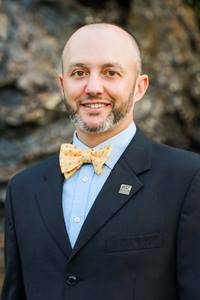Michael Guarraia

Michael Guarraia
Fellowship Placement: National Aeronautics and Space Administration
Hometown: Owings Mills, MD
Michael Guarraia started his STEM career as an engineer. Graduating with an engineering degree in the spring of 2000, he worked for Lockheed Martin for six years, taking on increasing levels of responsibility throughout his tenure with the defense contractor. His work took him all over the country, as well as internationally, collaborating with other engineers and solving technical problems on advanced military equipment. During his time as an engineer, Michael also worked as a part-time rock climbing instructor and volunteered with Big Brothers Big Sisters. This combination of extracurriculars led to a love of working with children, and helping people make progress towards a goal. As such, in 2006, Michael was accepted into an NSF-funded program to bring STEM professionals into the classroom. He spent a year student-teaching under the guidance of a mentor teacher while simultaneously earning a Masters of Arts in Teaching from the University of Maryland Baltimore County. Michael went on to teach middle school science in Baltimore County for the next nine years. Throughout his tenure in the public school system, Michael became a department chairperson, and also helped write curriculum for the district, which serves over 100,000 students. To keep busy during the summers, Michael consulted for Achieve, Inc., to help write for the Next Generation Science Standards.
Around this same time, Michael’s wife (also a career changer, having earned her PhD in Molecular Biology) had been teaching in private schools, and routinely urged him to consider transitioning. Ultimately, the lure of more freedom to create and teach interesting classes and curricula won him over, and Michael began teaching upper school science at The Park School of Baltimore. There, Michael collaborated with colleagues to develop a new upper school science curriculum, aimed at both leveling the playing field for all students, as well as providing early exposure to both engineering and computer science.
Michael has earned numerous accolades, both local and national, throughout his thirteen years in the classroom. In 2016, he was featured in an NPR story on engineering education for his work guiding students to design and construct a human-powered amphibious vehicle for the Baltimore Kinetic Sculpture Race. In 2009, Michael took part in a Fulbright program in China, having developed curricula to use engineering instruction as a context for teaching English to primary students. Michael has been the recipient of numerous grants from agencies such as the Chesapeake Bay Trust, the Engineering Information Foundation and Lowe’s. He has had the opportunity to engage in some truly incredible professional development opportunities, including the Honeywell Educators at Space Academy, National Science Teachers Association New Science Teacher Academy and the Weightless Flights of Discovery Zero-Gravity Parabolic Flight Program. Michael has also served as both a writer and reviewer of curriculum materials for organizations such as Baltimore County Public Schools, Maryland Public Television and the Smithsonian Institute.
Michael was fortunate to be selected as a fellow for NASA during the 2020-2021 school year to help make STEM education more accessible to all students. As such, he developed and worked on programs to help connect NASA with Minority Serving Institutions (MSIs) at the university level, as well as rural educators grades K-12. Michael is thrilled to be back with NASA, and hopes to take his work to new heights during the 2021-2022 fellowship year.

